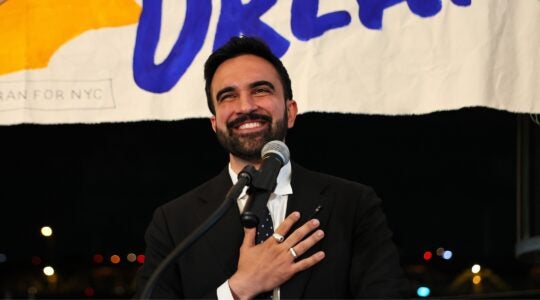With its focus on Jewish poverty here and in the former Soviet Union, UJA-Federation’s annual fund-raising campaign raised $129.5 million for the year ending June 30. Combined with donations to the capital campaign and planned giving and endowments, the philanthropy brought in $228.8 million: $25 million more than a year ago.
The outpouring of support (an increase of 11 percent) shattered all records, except for times when Israel was at war with its Arab neighbors, according to Stephen Solender, the organizationís executive vice president.
"We owe a profound sense of gratitude to so many New Yorkers who supported the New York federation in such a magnificent way," he said. "They are really helping us in a dramatic way to assist those in poverty. They have helped us to write a magnificent chapter in the history of our community. We can all be very proud of what we have accomplished."
According to Gary Tobin, president of the Institute for Jewish and Community Research in San Francisco and a leading demographer, "An 11 percent increase in an annual campaign for any nonprofit institution is a home run by any measure. I can think of a wide variety of universities, health care and cultural organizations that would love to report such an increase."
Klara Silverstein, who co-chaired the campaign with Jerry Levin, said the philanthropy’s success signaled a "recognition there is no other Jewish organization that saves more lives than UJA-Federation and that is able to implement far-reaching responses to the challenges we face."
These figures belie the predictions of pundits who just a few years ago were predicting the demise of federated giving in favor of designated gift giving, observed UJA-Federation’s chief executive officer, John Ruskay.
"While we recognize the strong economy was an important factor in the campaign, the results also represent a renewed commitment to community and Jewish peoplehood at a time when there are many challenges to the ties that bind us together," he said. "People have stopped at a moment in time and realized there was something precious at stake: a Jewish communal infrastructure that takes care of the most in need.
"At stake was the Hillel system for Jewish college students, feeding the hungry in the former Soviet Union, and taking care of new immigrants in Brooklyn or Israel. That would have been undermined and threatened if people turned their backs on a sense of collective responsibility. The results of this campaign represent a clear endorsement of it, and I think that everyone in Jewish life can take great pride in this accomplishment."
Silverstein said that in attending many of the campaign’s fund-raising events, she noticed that the poverty initiative, which was launched for the 1999 campaign, had resonance for many contributors. She pointed out that money raised by the campaign helped the American Jewish Joint Distribution Committee "care for the pressing needs of 185,000 elderly Jews living in the former Soviet Union."
"The JDC is feeding and taking care of them because since devaluation, the pensions they had counted on are worth less. If we had more money, we would take care of more."
Silverstein pointed out that UJA-Federation takes care of an almost equal number of Jews living at or near the poverty level in the New York area.
James Tisch, president of UJA-Federation, said "the poverty campaign and the hunger issues are very palpable for people. People really understood the issue of hunger. … We may continue the poverty initiative for one more year and then fold it into our campaign."
He said more people responded to the UJA-Federation campaign this year because "we are doing a better job of getting our story out and making our case. It’s a no-brainer to support this effort when you see whom we are supporting."
In addition, pointed out the organization’s board chairman, Judith Stern Peck, campaign leaders are connecting to potential donors.
"There’s a sense of being engaging and informing: we are really focused on what we are about," she said. "We want people to be a part of our community because what we do is very important. We help those in need and we want them to be a part of this. We’re very proud of what we do and of our capacity to help."
Peck pointed out that the work of UJA-Federation is "based on Jewish values. We make that clear in our ads, our speeches and letters to donors.
"If you want to give money to a charity, we’re one of the best because we have integrity. When you leave money to us, you know it is going to go where you want it to go. One donor called us his Jewish mutual fund: and we pay dividends in good feelings, knowing you are a part of a large global Jewish community. Our global network goes far and wide, and we are able to leverage more money to respond to those in need."
The number of donors to the 1999 campaign increased by 3,534 to 83,375, according to Ruskay. Since 1995 the donor base had shrunk, mirroring a decline in donors to federation campaigns nationally. In ’95 there were 94,000 donors, a figure that dropped to 91,000 in ’96, 90,000 the following year and about 80,000 in 1998.
"This was a first step in reversing that decline," said Ruskay.
He pointed out that the donors who had stopped contributing were those who had given the least amounts. Ruskay added that these donations had been acquired primarily by telemarketers and through direct-mail campaigns. The outreach had been curtailed for budgetary reasons two years ago, but Ruskay said it was reinstituted for the 1999 campaign and was largely responsible for the increase in donors.
"This represents an important decision that both the number of dollars raised and the number of donors are of great importance," he said. "During the next few years, our leadership has decided to undertake initiatives to engage larger segments of the New York Jewish community, so that the UJA-Federation campaign can represent the fullest expression of our community."
In addition to the $129.5 million raised by the annual campaign, Ruskay said the capital campaign raised $48.05 million, an increase of $10.1 million over the previous year, to bring the total raised by that campaign in 11 years to $1.05 billion. And he said the amount donated through planned giving and endowments was $51.07 million, an increase of $10.8 million over the 1998 campaign.
The New York Jewish Week brings you the stories behind the headlines, keeping you connected to Jewish life in New York. Help sustain the reporting you trust by donating today.




